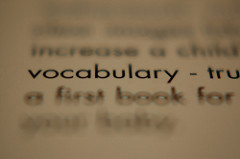Science vocabulary: See it, say it
By Mary Bigelow
Posted on 2015-08-29
 How do you make vocabulary terms meaningful for students? I’m talking about really getting them to understand how the word or words are used in context. I feel students often just copy down a definition and never truly grasp how it relates to the topic at hand. —S., Missouri
How do you make vocabulary terms meaningful for students? I’m talking about really getting them to understand how the word or words are used in context. I feel students often just copy down a definition and never truly grasp how it relates to the topic at hand. —S., Missouri
Science students at all grade levels struggle with the vocabulary. They are SLLs—Science Language Learners. Textbooks and websites are full of specialized words that challenge our students. Some are technical and relate specifically to science (e.g., photosynthesis, thermodynamics, plate tectonics) while others have meanings in science that differ from common usage (e.g., theory, hypothesis, matter). Even the graphics in books and websites go beyond being decorative to include the language of science in tables, diagrams, graphs, captions, sidebars, and footnotes.
Sometimes we assume students understand a word, only to find out on an assessment that they are confused. For example, my middle school students often interchanged the words medium and median, and they didn’t realize that media was the plural of medium. No wonder the room was sometimes full of puzzled looks.
There are many strategies to help students with vocabulary, most of which involve reading and writing and focus on definitions. Common strategies include graphic organizers (such as the Frayer Model), word walls, student-created flash cards with definitions and pictures, vocabulary games, and notebook exercises.*
As you mentioned, students need to go beyond writing definitions to recognizing and using the words in context. Before reading, students are often given a list of words to define. I wonder what would happen if students looked at the text first to see the context in which the words were used. Can they use any context cues to figure out a definition before resorting to the glossary? (They may need some guidance on using cues. This could be an interesting action research topic.)
I had success with showing students how knowing common affixes and root/base words can help in figuring out what a word means. For example, when my students first encountered the word “photosynthesis,” I pointed out that “photo-” means “light,” and we brainstormed other words that started with photo and had something to do with light (photograph, photocopies, photojournalism). They had a page in their notebooks for these “word parts.”
In my experience, for students to understand and use new words, they also need to hear and say them. Sometimes what students wrote had little in common spelling-wise with the actual word. They could recognize the word in written material and match it to a definition, but many had difficulty pronouncing the word, generating the word in oral conversations, or using it in their writing.
I shared my dilemma with an elementary level colleague. He suggested that for more complex or unfamiliar words, have the students repeat the words several times out loud, emphasizing the syllables by clapping out each syllable: met-a-mor-pho-sis. I tried this with my middle and high school classes, and it did help them with pronunciation and spelling. (Be prepared for some eye-rolling at first with secondary students, so explain why you are asking them to do this.)
An article from the July/August 2013 issue of the Journal of College Science Teaching (JCST), “On the Road to Science Literacy: Building Confidence and Competency in Technical Language Through Choral Repetition,” shared an intriguing study on the effects of choral repetition on science learning in college science classes. They went further than my action research and did a more formal study of the strategy.*
In addition to the quantitative findings, the authors include perceptual feedback from the students. Among other findings, students reported that the strategy helped them remember the terms, it was a cue that the term was important, and it was something that would apply to other courses. “You are not as afraid to use the big words when you understand them better” and “the words or phrases that we repeated in class pop out more when you read it than if you never heard the word before…you would probably just gloss over it.” This is a simple strategy that requires no professional development or materials.
I’d be interested in hearing from you on any strategies you find useful!
* I’ve created a Learning Resource Collection–—Vocabulary: The Language of Science—with articles from NSTA publications and other websites on the topic, as well as the JCST article mentioned above.
Related NSTA blogs:
Disclaimer: The views expressed in this blog post are those of the author(s) and do not necessarily reflect the official position of the National Science Teaching Association (NSTA).


